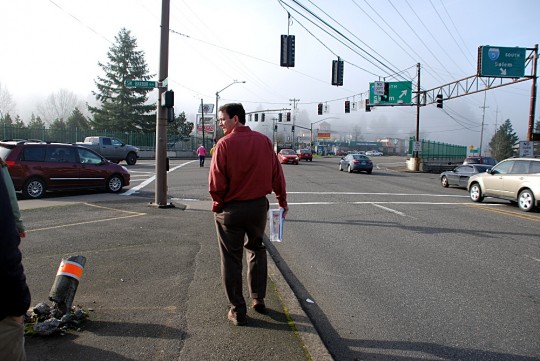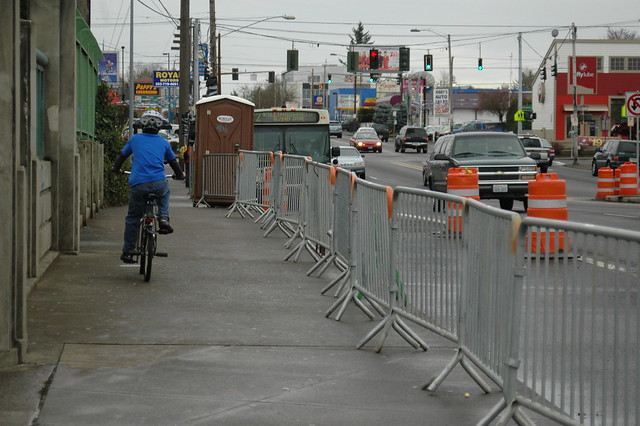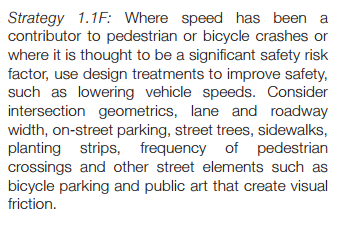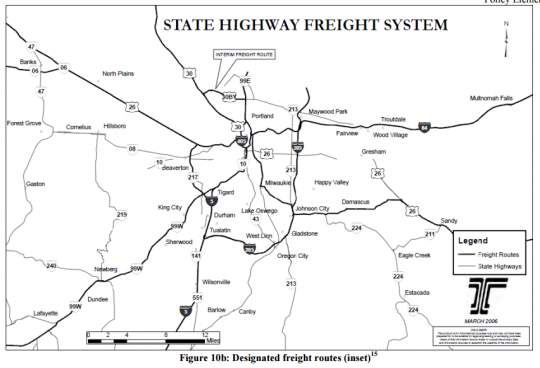
(Photo by M Andersen/BikePortland)
Staff from bike advocacy groups, from the Metro regional government and from the Portland office of the Oregon Department of Transportation are all pushing for significant changes to a document that will be the foundation of bicycle planning for the next quarter century.
Serious concerns are being expressed about ODOT’s draft of its next Bicycle and Pedestrian Plan. Among the points of contention: the plan doesn’t explicitly say that the state should be putting complete biking and walking facilities on highways like Southwest Barbur, Southeast Powell or Northeast Lombard.
That stands in contrast to the previous state plan, published in 1995, which describes such arterial highways as “potentially the most important element of a complete network of bikeways and walkways.”
“Oregon’s draft does not meet Oregon’s standards in other plans nor does it meet the current Federal recommendations.”
— seven biking and walking advocates in a November letter to the Oregon Transportation Commission
Instead, the draft plan refers to times when state and local agencies might see “a local parallel route as desirable to the state highway,” without mentioning improvements of the highways themselves.
In its comments to the Salem-based headquarters, ODOT’s Portland regional office points out that this phrasing seems to imply that routes parallel to a state highway (like the proposed 70s Bikeway, for example, or a riverfront trail north of Lombard) are enough to satisfy the state law that requires biking facilities to be “provided wherever a highway, road or street is being constructed, reconstructed or relocated.”
“As written, this policy implies that stating a preference for a parallel route eliminates ODOT’s obligation under the Bike Bill to serve bicycles and pedestrians on the state highway, which would be wrong,” the local ODOT office wrote.
ODOT is currently inviting public comments on its draft. The comment period closes in two weeks, on Feb. 18.
State officials and regional politicians echo advocates’ calls for more detail

Walking and biking advocates have been going to unusual lengths to sound alarms about what they see as problems in the new Bicycle and Pedestrian Plan draft.
In November, seven advocates and policy committee members from around the state went over ODOT staffers’ heads to call attention to their concerns at the Oregon Transportation Commission, the body appointed by Gov. Kate Brown to function as ODOT’s governing board.
“Oregon’s draft does not meet Oregon’s standards in other plans nor does it meet the current Federal recommendations” for assessing the road system, their letter warned.
Next week, four advocacy groups — three that focus directly on biking and walking, plus AARP Oregon — will co-host a feedback session in inner Northeast Portland aimed at gathering public comments about the draft.
Advocates, though, aren’t the only ones raising concerns.
Advertisement
On Friday, all seven elected councilors of the Portland regional government Metro sent a signed letter to ODOT urging the agency to at least acknowledge the importance of biking facilities on major streets by recognizing the “bicycle and pedestrian networks in the adopted Regional Active Transportation Plan as of statewide significance.”
“The pedestrian and bicycle networks in the Regional Active Transportation Plan have been developed over many years through extensive collaboration with local governments and the public,” the councilors wrote. “They provide the spine for the local pedestrian and bicycle networks and are included in local transportation system plans.”
ODOT’s own Portland-region planning manager, Jon Makler, raised similar issues in a Dec. 8 letter to ODOT Principal Planner Savannah Crawford:
How does ODOT see the role of the state highway system? The 1995 plan, for example, discusses the need to integrate active transportation networks with existing infrastructure rather than to create a separate network. It also acknowledges the role of principal arterials as the backbones of these existing networks, noting that state highways serve this role in many communities around the state.
ODOT manager says new plan will improve on 1995’s
In an October interview about the draft plan, ODOT Transportation Planning Manager Amanda Pietz said her team had been working to respond to such concerns, but defended the draft plan in general.
“I’ve heard them say the 1995 plan was more progressive,” she said. “But then I ask, ‘What did the 1995 plan actually do on the ground?’ and people have a really hard time answering that.”
“It does not include specific projects; none of our statewide policy plans do,” Pietz said. “It’s also a statewide plan and we don’t have the authority as ODOT to put local jurisdictions’ projects on that list.”
Pietz said she is proud of other “progressive things that are in there,” such as Policy 1.1F:
Pietz said that this is a major step for Oregon: suggesting that it might sometimes be desirable to slow traffic on dangerous streets.
“To open up the speed question of considering speeds, that’s a huge issue,” she said. “If we look back five, 10 years ago, I don’t think we would have had that conversation.”
Pietz said ODOT’s plan can’t be as “progressive” as some people want because “it has to be a statewide document that is accepted by our commission and the State of Oregon.”
Advocate: The current plan is ‘offensive’
Bicycle Transportation Alliance Advocacy Director Gerik Kransky said in an email Thursday that the state’s failure to call for specific biking and walking standards for particular road segments is “offensive.”
He said the plan should commit the state to reviewing all its streets and deciding which ones need what type of biking and walking facilities.
“I think the most egregious foul in this plan is the lack of commitment to updating the functional classifications on ODOT facilities,” Kranksy said. “Look at how the freight plan commits to providing a specific network of roads that meet specific standards for performance. It is offensive that ODOT would not do the same thing for bike/ped.”
Here’s an example from the Oregon Highway Plan: a map of Portland-area streets that are important to freight traffic.
The Bicycle and Pedestrian Plan has no such maps, and no detailed inventory of streets that identify what sort of freight access is needed on each street.
Where the freight plan devotes many pages to economic analysis of the sources and economic impact of freight, the Bicycle and Pedestrian Plan speaks about the importance of biking and walking much more generally.
As advocates noted in their November letter, the state doesn’t consider which neighborhoods might be in particular need of good biking and walking because so many people lack cars. Nor does it attempt to measure where biking and walking are currently popular, or where they’re important to the state’s economy.
Jenna Stanke, special projects manager for Jackson County Roads and Parks in Medford and one of the signatories to the November letter, said in an October interview that she had “fairly full confidence in ODOT that this isn’t the final end-all, that they’re open and willing to have more conversations.”
After all, Stanke said, ODOT’s other plans call for spending many millions of dollars to add many more lane-miles of highways around the state, though the agency lacks the money to build them.
“We’re looking at all these big projects that are supposed to mitigate congestion,” Stanke said. “Is that the highest and best way to solve those problems?”
ODOT is accepting comments on its plan online until Feb. 18.
— Michael Andersen, (503) 333-7824 – michael@bikeportland.org
BikePortland can’t survive without paid subscribers. Please sign up today.









Thanks for reading.
BikePortland has served this community with independent community journalism since 2005. We rely on subscriptions from readers like you to survive. Your financial support is vital in keeping this valuable resource alive and well.
Please subscribe today to strengthen and expand our work.
It’s hard to believe that the plan actually matters if you read the 1995 one and look around you. Maybe if they cut 200-300 pages, it would be worth considering.
I’m getting sick and tired of ODOT. There needs to be some political movement to reform ODOT at its highest levels.
“…There needs to be some political movement to reform ODOT at its highest levels.” yashardonnay
To what end? Lots of people think lots things need change, but when they don’t say what those changes should be, it’s near impossible to move towards change deliberately.
Currently, I think, easily a majority of Oregon residents get what they want from ODOT, which is maintenance, and at the least, and eye on expansion of roads for motor vehicle use to meet demands of a growing population and corresponding economy. That use is a fundamental priority, over-riding all other road infrastructure provisions. The state transportation department is obliged by the public to meet that priority.
Sidewalks and bike lanes, components of so called ‘complete streets’, on big thoroughfares? As I wrote in an earlier comment here, that’s a good idea, I suppose, but realistically…who wants to walk or bike in those traffic environments? So is the idea behind reform, hopes for the building of a lot more walk and bike infrastructure that nobody wants to use for walking and biking?
I think people that are a minority group, just calling for reform, because they don’t like the decisions leadership is obliged to, and do make, isn’t a very good means towards reform. If the desired changes aren’t what the majority can relate to and support, it doesn’t seem very likely that the majority would support reform to bring about those changes.
Nobody is surprised, are they? It’s hard to muster the effort to comment on the plan, because even if there are changes to it, and even if those changes reflect the desires of Oregon’s residents, the criminals at the top of ODOT will do nothing in practice if there is any kind of conflict with freight interests or LOS.
I’m not happy sounding like a broken record on ODOT. I wish once in a while I could say something nice about them. Not holding my breath, though. ODOT is a sick and diseased agency. Maybe the best thing to do is shut it down and start again.
This bike “plan” is really more of a plan to get bikes out of the way. Why should we trust ODOT with our lives?
Where is the leadership?
“I’ve heard them say the 1995 plan was more progressive,” she said. “But then I ask, ‘What did the 1995 plan actually do on the ground?’ and people have a really hard time answering that.”
A powerful comeback.: The 1995 plan was shitty. And this one, well, it is also shitty, just in a more obvious way.
That quote stood out to me as well. Isn’t she just admitting that they have done a bad job of upholding the law?
“…highways like Southwest Barbur, Southeast Powell or Northeast Lombard. …” bikeportland
Hard to really know what traffic on those type roads will be like, some distance into the future. It’s likely to change in some way though. Generally, I consider the environment for biking or riding on such roads with the traffic they presently have, to be a hostile one, whether or not they were to have good bike lanes and sidewalks. I’m afraid the alternative though…no good infrastructure on those highways for walking and biking…could allow them to evolve into an even more hostile environment whose negative effects could penetrate further into nearby neighborhoods.
Relative to that potential, I think that comments of ODOT Transportation Planning Manager Amanda Pietz, quoted in this story with regards to the question of reducing speeds on some Oregon highways, are encouraging.
The simple, inescapable fact is, though populations of various big cities through which state highways pass, are likely to grow larger, the highways themselves stand virtually no chance of becoming accordingly wider to meet a possible…some would say ‘likely’, increase in use of the road with motor vehicles. The widths of all the roads mentioned in the quote, and others such as Beav-Hillsdale, T-V Hwy, and Canyon Rd in Beaverton,are set, and my feeling, is additional width that would be needed to create more main lanes primarily that would facilitate growth in motor vehicle use on them, isn’t going to happen.
In short: Even though the traffic environments of those highways for walking or biking now are hostile, I think a ‘complete streets’ provision in a new bike plan would be important to sustain.
Slowing down motor vehicle traffic on the type of highways named, by itself, would do a heckuva lot to improve conditions for walking, biking, and just simply living in neighborhoods the highways pass through.
OMG! Blaming a plan for not resulting in action? really? A plan is just that, a plan. Because ODOT failed to act and/or implement elements of the plan is not the plan’s fault. The failure is the organization in not choosing to follow or implement that plan.
Another reminder to comment with ODOT and not just on BikePortland. Echo chambers always have good ideas.
The plan is the mission statement. The highest levels of odot don’t care about anything unless it contains an engine. The last holdouts of 1960 are camped out in downtown portland waiting for Lars Larson to save them from the evil bike riders and walkers.
Maybe its time to ‘start a discussion’ to consider transferring control of certain ODOT controlled roadways within the city limits to PDOT control. Roadways that are in emerging urban areas are just not best served by ODOT’s model of maximizing induced traffic demand at the cost of vulnerable users.
Any new guideline should also include a requirement that an induced demand analysis be done for each project as well as a quantified bicycle level of service analysis, based on the newer models developed over the last few years.
BOTH PBOT AND ODOT have signed onto Vision zero and both of the organizatiions have concluded that the only way to eliminate pedestrian and cyclist deaths is to eliminate ALL pedestrians and cyclists, from the thoughways and byways, and to eliminate anywhere that cyclists or pedestrians can interfere with motor traffic.
As far as I know ODOT hasn’t adopted Vision Zero.
Tom,
Once again, I call B******t.